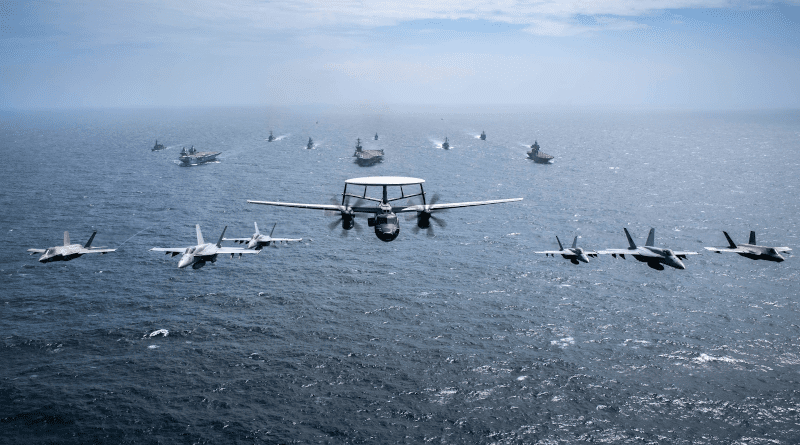Aligning AUKUS And The Quad For Australia’s Defence – Analysis
By Akash Sahu*
The conversation on AUKUS and Australia’s defence indicates the need for an advanced industrial base in the country, which can sustain not only the development of nuclear-powered submarines but also align capabilities like hypersonic and Artificial Intelligence (AI)-led military systems. Limitations like the lack of capital and human resources drag down Canberra’s ability to develop better weapons.
Collaboration with AUKUS partners (the United States and the United Kingdom) is crucial for Canberra to procure, test and commercialise the latest military technologies. At the same time, deeper engagement with Quad partners Japan and India can help ensure a robust supply chain network for Australia’s defence industry sector. Both AUKUS and the Quad are driven by shared motives of stabilising regional security in the Indo-Pacific.
The developing geopolitics of the Pacific necessitate credible offensive and defensive capabilities. Mick Ryan from CSIS suggests that Australia should move to short-term ‘asymmetric’ deliverables that can deter Chinese aggression, instead of its heavy focus on longer-term force structure plans. Nuclear-powered submarines will take more than a decade to be ready, but escalating tensions demand at least some capability enhancement within 3–5 years. Since the threat is regional, it involves multiple stakeholders. The development of Australia’s defence industrial base would be easier and faster through institutional collaboration with like-minded partners in the region.
Australia has a strong foundation in research and development. It also exports some defence items, such as the Nulka Active Missile Decoy and Bushmaster Protected Mobility Vehicle. According to the 2020 Force Structure Plan, Canberra will commit more than US$20 billion to develop high-speed weapons and build defence capabilities against ballistic missiles and high-speed weapons.
The Australian government’s Defence Innovation Hub allocates grants to businesses developing AI technologies with military applications. Some of these include improving situational awareness using available intelligence and achieving intelligent virtual reality for better simulation, modelling and training of the Australian Defence Force. Other programs like the Australian Industry Capability program and Local Industry Capability Plans aim to increase the participation of local defence manufacturers in defence infrastructure projects. Agencies such as Austrade have helped domestic tech firms set up research facilities to test advanced technologies and market commercialisation.
Limited capital affects manufacturing for the market and drags down innovation. Even though Australia attracts considerable foreign direct investment, the financing for defence manufacturing remains limited due to reasons including risk, institutional hurdles and lack of trust.
Japan ranked second globally in video game equipment exports in 2020 and has seen strong exports in digital items and semiconductor equipment despite the COVID-19 crisis. In 2021, Japanese foreign direct investment in Asia and Oceania amounted to US$655 billion, with investment in Australia exceeding US$162 billion. Japanese banks have led the growth in project finance in Asia and are apt contenders for financing progress in critical technologies.
The signing of a Reciprocal Access Agreement between Japan and Australia was accompanied by increased bilateral cooperation in the digital and cyberspace sectors. There is potential for work on innovative technologies, AI and autonomous robotic systems that target the grey-zone operations of an adversary.
India has a formidable base in cyber services and digital technologies. A Defence Artificial Intelligence Council and Defence AI Project Agency have been created within the defence establishment to work on AI-enabled defence products. The Indian Navy is working on 30 AI-related projects covering areas such as maritime domain awareness and autonomous systems, while the Indian Army has set up an AI centre of excellence in Mhow.
India’s defence minister released 75 AI-related products at the ‘AI in Defence’ symposium in July 2022, which have been developed through partnerships between the armed forces, defence research organisations and private industry. India also declared massive ‘Make in India’ initiatives for self-reliance in defence manufacturing, which may be vital for critical defence supply chains in Canberra’s defence industrial development plans.
Even though the Quad members have unique strengths in AI, their collaboration and investment in AI-related projects are minimal. For Australia, it may be useful to align more with Japan and India for focussed efforts on the military applications of AI technologies.
Washington has robust cooperation and investment across all three countries on AI. But there are reasons to believe that among the AUKUS partners themselves, technology sharing is a sensitive issue and there are comprehensive regulations in place to prevent it. The role of the US Congress in reducing export controls and streamlining information exchange will be critical to allowing greater collaboration.
Loosening export controls can help Canberra to capitalise on the strengths of Japan and India in developing Australia’s defence base. The policy discourse around AUKUS in London will be important in engaging the Quad for achieving AUKUS objectives and Britain’s own ‘Indo-Pacific Tilt’.
The Sydney-based United States Studies Centre recommends an ‘AUKUS Visa’ to ensure a steady flow of talent to sustain the momentum in defence production under AUKUS. To facilitate the development of Australia’s defence industrial base, Canberra also needs to engage with Quad partners.
Though AUKUS and the Quad are different in their objectives and orientation, they aim for a stable Indo-Pacific where the rules-based order prevails. Canberra needs to find ways of synchronising the two to deter disruption in its Pacific neighbourhood.
*About the author: Akash Sahu is a researcher based in New Delhi who specialises in Indo-Pacific geopolitics and Southeast Asian studies.
Source: This article was published by East Asia Forum

